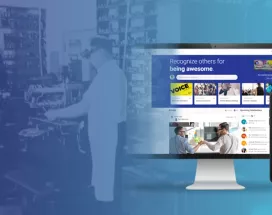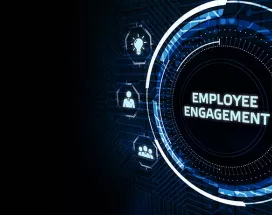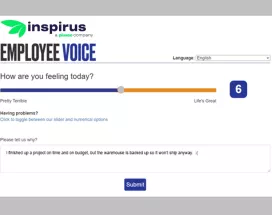Inspirus Blog
Welcome to our space where we celebrate the power of rewards, recognition, and robust employee engagement. Dive in to discover transformative solutions that elevate workplace culture, boost morale, and drive unparalleled performance. Let's embark on a journey to appreciate, motivate, and empower your most valuable asset: your people.

Employee Engagement
By Aspen Christopher
Employee engagement is a hot topic in most business circles and has been for quite some time — for a very good reason. Engagement matters for business growth. When employees are engaged with the work they do and the organizations they do it for, they’re more productive, less prone to absenteeism and turnover, and more loyal.

Employee Engagement
By Kelley Briggs
These are moments that matter. Those feelings of recognition, community, and achievement are what a thoughtful, comprehensive employee engagement strategy can deliver. Personalized Celebration Program and personalized celebration program is an important way to recognize and show appreciation for employees at an individual level. It goes beyond a one-size-fits-all approach to mark the moments for each employee, creating a more meaningful, impactful experience.

Employee Engagement
Rewards and recognition programs are a great way to motivate and engage employees. They can help boost morale, increase productivity, and improve overall job satisfaction. However, setting a budget for these programs can be challenging. Here are some tips to help you set a budget for a rewards and recognition program so that you can create a thriving culture that satisfies your employees and suits your bottom line.

Employee Engagement
By Kelley Briggs
There is no one way to “do HR” right — but many of the traditional models and practices in the HR scope are quickly becoming outdated, so there are lots of ways to get it wrong. Today’s HR leaders are expected to be in tune with the needs and expectations of employees and job seekers. In broad strokes, those include the desire to feel supported and included at work, to have access to real career opportunities and to have the flexibility and freedom to fit work into their lives, rather than the other way around. HR leaders and C-suite executives are at a crossroads: they must identify outdated practices and craft a new HR playbook, or risk falling behind and losing employees to organizations who have already redefined the strategic role of HR.

Culture
By Kelley Briggs
If you haven’t asked your employees what’s important to them lately, now is the time. We see a critical need for organizations to develop ongoing processes for gathering — and acting on — employee feedback.

Employee Engagement
By Andy Davis
Last year, Forbes suggested a list of technology investments including cloud cost optimization, integrated software delivery platforms, business applications that protect assets and people, resilient operational infrastructure, distributed data platforms, and more. HRExecutive.com reported data from WorkTech showing how global HR technology capital investments would outperform the rest of the market through the first half of 2022. So, while the rest of the market is sluggish, HR tech continues to thrive. Why?

Culture
By Theresa Harkins-Schulz
Building a workplace community that is supportive and social has the potential for positive impact on both company morale and productivity. Both employees and the organizations they work for benefit.

Culture
By Aspen Christopher
May is Mental Health Awareness Month, an important commemorative event that could, sadly, go on year-round. It’s a movement to raise awareness about mental health — something that both employers and employees are, unfortunately, well aware of these days.

Culture
By Mia Mends
With the recent release of Sodexo's 2017 Global Workplace Trends Report comes a compendium of rich content from one of the world’s largest employers along with global news sources and nearly 50 subject matter experts from renowned academic institutions, associations, consultancies, foundations, NGOs, research groups, think tanks and more.

Employee Engagement
By Kelley Briggs
In the past two years, HR leaders have seen talent recruitment and management turned upside down and inside out. The ‘Great Resignation,” hybrid work arrangements, and “quiet quitting” have impacted how HR leaders do their jobs, how employees respond to the “new normal” in their workplace, and what role organizations play in satisfying employees’ personal goals. One thing we have learned is when organizational leaders make an investment in the long-term success of their employees (a proactive mindset) rather than simply getting bodies back into seats (a reactive response), employees are happier and more motivated to perform at their highest levels.

Culture
By Kelley Briggs
When G W Haltom opened Haltom’s industries in 1893, the company was known as a jewelry manufacturer that made belt buckles, lapel pins, rings, and watches — including some used to mark employees' service anniversaries or reward them for their hard work. Fast forward 130 years and it is unlikely he could have known how impactful his vision was, as Inspirus has now become a leader in employee recognition and employee engagement services. Let’s take a trip down memory lane.

Employee Engagement
By Kelley Briggs
When the term “quiet quitting” emerged in March of 2022, it painted a picture of lazy, entitled employees — or at least those with unrealistic expectations about their work.

Employee Engagement
By Kelley Briggs
The now popular term “employee engagement” was originally coined by Professor William Kahn with Boston University in 1990 in his paper, “Psychological Conditions of Personal Engagement and Disengagement at Work.”

Employee Feedback
For many organizations — especially service organizations — employees are their primary resource. In any company environment, though, employees are a critical driver of organizational success. Their feedback is critical to improving the employee experience, company culture, and business operations.

Employee Feedback
By Theresa Harkins-Schulz
The pandemic and mass exodus of the Great Resignation gave organizational leaders a wake-up call: work culture needs to improve. Your organization already has a culture and you might think you know what it is — but your employees can tell you the real, whole story about the culture you actually have. And chances are, your culture could stand some improvement, even if you think your employees are happy.